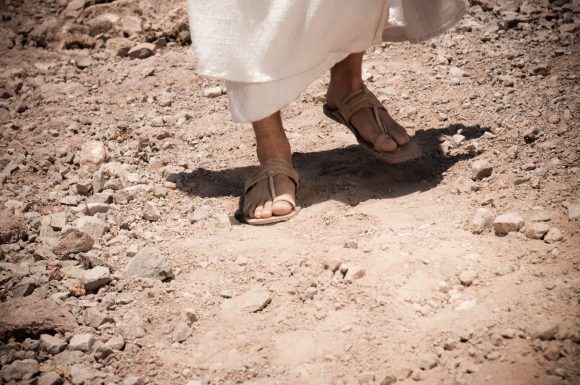This morning I want to talk to you about the first apostle. Children often ask the difference between an apostle and an epistle. It is easy to tell them apart. An epistle is a letter sent by one person to another person (or group of people). An apostle is a person sent by one person to yet another person (or group of people). An epistle communicates in writing. An apostle communicates in person. When God wanted to send us his very best, God did not just send an epistle, God sent an apostle. In fact God sent more than one.
When Jesus lived in Galilee, he appointed twelve apostles to be with him, and he sent them out to announce that the kingdom of God was at hand. The powers of Jerusalem and Rome rejected the kingdom of God, and they killed the king, Jesus. But following his death and resurrection, Jesus showed himself alive to his apostles by many proofs, then he sent them out to announce victory over the still more awful powers of sin and death.
The apostles of Jesus were a diverse group. We know that Peter, Andrew, James and John were fishermen. Matthew was a tax collector, and Phillip was probably a merchant. Simon the Cananaean was a political zealot, and Paul, who came later was a tentmaker. Of course, the person that we call the first apostle was even more special, for she was a woman, Mary Magdalene.
If you and I had lived in the 1st Century, and had we worked in Human Resources for God, and had we been charged to choose the first apostle, we probably would not have chosen Mary Magdalene. Mary had three big liabilities.
First, she not the politically correct choice. Today, a woman runs General Motors, and a woman very nearly ran our country. In those days, every male Jew rose up in the morning to pray: “O LORD, I thank you that I am not leper, or a Gentile, or a woman.” Women did not even have the right to bear witness in a court of law.
Second, Mary was not socially acceptable. There were rumors about Mary way back then, and they still persist. Some scholars think Mary Magdalene was the woman in John 8 who was taken in the act of adultery. The evidence is almost non-existent. Jesus saved that woman from being stoned to death, and Jesus saved Mary from something big, so some think the woman was Mary. Other scholars think Mary Magdalene was the woman in Luke 7. This nameless woman washed the feet of Jesus with her tears, and dried them with her hair. People at table with Jesus criticized him for letting this immoral woman even touch him. Jesus saw only the beauty of her act. So Jesus said to his host, “those who are forgiven little, like you, Simon, love little, and those who are forgiven much, love much.” The evidence is thin, but the nameless woman loved much, and Mary loved much, so some think she was the woman.
Third, and this cannot be denied, at one time, Mary may have lacked mental stability. In Luke 8:2 we read that when Jesus healed Mary, seven devils had gone out of her. In most HR departments that would be a deal breaker. Most People look at us see the worst in us, and say, “When you are at your worst, that is who you are!” Thankfully, God looks at us, and sees the best in us, and says, “When you are at your best, that is who you are!”
You would and I would not have chosen Mary to be the first apostle, but God did. Mary had several outstanding qualifications. Unlike the Apostle Paul, she was a follower of Jesus during his ministry. Unlike the Apostle Peter, and most of the other male apostles, Mary followed Jesus to the bitter end. At the first sign of real trouble, all the male apostles save the beloved disciple forsook Jesus and fled. According to John 19:25 Mary Magdalene was standing at the foot of the cross when Jesus cried out, “It is finished,” and breathed his last. According to Matthew 27:61 Mary Magdalene follow Joseph of Arimathea when he laid the lifeless body of Jesus in a garden tomb.
In the text before us this morning, John records how Mary Magdalene became the first apostle. On the first day of the week, the day we call Sunday she was back at the tomb. Though it was still dark, she saw that the stone had been rolled away, so she ran to Simon Peter, and the other disciple, the one whom Jesus loved, and said to them, “They have taken the Lord out of the tomb, and we do not know where they have laid him.”
Peter, and the other disciple, whom most people think was John the son of Zebedee, decided to check it out. They both ran to the tomb. John was younger and faster, and he reached it first; but he did not go in. He stooped down and looked-in, and when he did, he saw what there was to see. He saw the linen cloths lying there, and the napkin, which had been on the head of Jesus, rolled up in a place by itself. Peter then pushed by John, and actually went into the tomb first. But Peter was puzzled by what he saw, for, as the text says, “the disciples did not (yet) know the scripture that Jesus must rise from the dead.” Then John went into the tomb, and the text says, “He saw and believed.”
Some people say that because John saw and believed he was the first apostle. That is not so! John was merely the first to have faith. When John saw the peculiar arrangement of the grave clothes he believed in the resurrection even before he saw the Risen Christ. Thus he is the first to enjoy the blessing the Risen Christ pronounced when Thomas finally saw him and believed: “Do you believe because you have seen me? Blessed are those who have not seen and yet believe.” (John 20:29)
The text says that Peter and the other apostle went back to their homes. Then Mary, who must have followed them back to the garden, went into the tomb and saw two angels in white sitting where the body of Jesus had lain. And they said to her, “Woman, why are you weeping?” And she said, “Because they have taken away my Lord, and I do not know where they have laid him.” In the synoptics, the angels tell Mary that Jesus has risen. Here in John, they say nothing, for as Mary is speaking to the angels, she turned and sawJesus standing there; but (here is the kicker) she did not know it was Jesus.
At least four times in the resurrection narratives of the gospels, disciples see the Risen Christ and do not recognize him until Jesus himself does something to reveal his true identity to them. Some will ask, “How could it be that people who knew Jesus so well failed to recognize him?” The answer to that is simple. When God creates, God does it right, so God can pronounce it, “Good!” And when God gave Jesus a new body, he did it right, so he could pronounce it, “Good!” God looked upon Jesus and turned his body of weakness into a body of strength. God looked upon Jesus an turned the body of his humiliation into a body of glory! God looked upon Jesus and turned his physical body into a spiritual Body. The disciples may not have recognized Jesus because he looked so good! But let’s get back to the story.
When Mary turned, Jesus said to her, “Woman, why are you weeping? Whom do you seek?” Supposing Jesus to be the gardener—no doubt because he was so lean and tanned and fit, Mary said to him, “Sir, if you have carried him away, tell me where you have laid him, and I will take him away.”
Mary is still locked into her grief. Immediately, Jesus acts to call her out of it. He knows that his sheep hear his voice (John 10:27), so he calls the Magdalene by name, saying, “Mary!” And Mary immediately answers him, saying, “Rabboni!,” which means, “teacher.
In his book, “The DiVinci Code,” Dan Brown popularized one of the ancient rumors about Mary and Jesus. Some early heretics said Jesus did not really die on the cross, but merely swooned, and later recovered to run away with Mary and have children with her. In the text before us this morning, Mary puts the quietus on that nonsense for she does not greet Jesus as her lover or as her husband, but as her teacher.
Oh! What he had taught her. Jesus taught Mary that “God don’t make no junk.” Jesus taught Mary about fresh starts and new beginning. Jesus taught Mary the height and depth and length and breadth of God’s grace, and love, and forgiveness. And Jesus taught Mary the joy of friendship and community when he said, “Greater love has no one than this, that one lay down one’s life for one’s friends.” Jesus laid down his life for Mary, and for us, all at once, on the cross. It was a perfect sacrifice. Mary laid down her life for Jesus little by little, in her faithfulness to Jesus. When she followed Jesus across the Judean desert, and listened to him teaching the multitudes, she laid down a little of her life. And when he was thirsty and she brought him water, and hungry, and she brought him food, she laid down a little of her life. And when she followed him through the streets of Jerusalem as people mocked him, she laid down a little of her life. And when she watched Jesus nailed to the cross and murdered, she laid down a little of her life. You get the picture. It occurs to me that you and I may never be called upon to lay down our lives for our friends and family as Jesus did, all at once, but all of us can lay down our lives as Mary did, making the hundreds of little sacrifices that make life more bearable for the people around us. Jesus says that in serving them, we are serving him.
The last thing that Jesus taught Mary was not about life, but about eternal life. He was different, but he was the same. She recognized him! There was a continuity between who he was before his death and resurrection and who he was after. I don’t know how Mary recognized Jesus. Perhaps she saw the print of the nails in his hands. God left those marks of honor and heroism in place. (John 20:27) Or, perhaps she saw a familiar expression on his face.
All human beings have a need to be known, even, one supposes, Jesus. Heaven will not change that, and, for that reason we don’t want to change too much. For instance, when I get to heaven and get my new body, I want whiter, stronger teeth, and smaller ears. And I hope that God will “undeviate” my deviated septum because I am really tired of my sinus problems. And I would like to get rid of one or two of my chins. Can I get an Amen? But I still want to look like me and be me, just better. People ask me if we will recognize the people we love in heaven. Of course we will. How could it be otherwise and still be heaven? We will be related to them differently (Mark 12:25), but we will recognize them.
Mary recognized Jesus, and the text before us assumes that she embraced him. In Matthew’s version of this meeting, she embraced his feet, as is fitting for a disciple and her teacher. Then Jesus said to her, “Do not hold me, for I have not yet ascended to the Father.”
Some people think this statement means that the glorification of Jesus is not yet complete. They think his body is new and better, but it is still half-baked, so to speak. They think that he must still ascend to the Father so the Father can finish the job. This is not right. Jesus has already told his disciples that he was going away, and that he was going to the Father. He also said, “It is to your advantage that I go away, for if I do not go away, the Counselor will not come to you; but if I go, I will send him to you.” A week later, the Risen Christ breathes upon his disciples and says, “Receive the Holy Spirit!” From that time forward, Mary and all the rest will know him more intimately than they have never known him before.
Therefore Jesus tells Mary not to hold him, but to go and tells his brothers that he is ascending to his Father, and their Father, to his God and to their God. He is ascending to his God, and their God, because Jesus in one of them. They are his brothers. In the incarnation, the Word became flesh, and he will never lay that flesh aside. He is ascending to his Father, and their father, because, as we read in the first chapter of this same gospel, through the power of the Holy Spirit Jesus has given all who believe in him the power to become the children of God, born not of blood, nor or the will of the flesh, nor of the will of man, but of God. (John 1:13) So Mary Magdalene obeyed. She went and said to the disciples, “I have seen the Lord.” In this simple act, she proves herself the first Apostle, because she is not only the first to see the Risen Lord, but also the first to share that Good News with others. Let us go and do as she did! We cannot be the first, but we can follow.
Finis
Worth Green, Th.M., D.Min.







